A week ago 20 people interested in the arts in therapy participated in one of my workshop/presentation. The AATQ was hosting its bi-yearly conference and creative arts therapists were invited to team up with other creative arts modalities to present on the interconnected nature of the therapeutic arts. I paired up with Renée Biancolin, recent graduate drama therapist who interned under my supervision here at the Douglas. Ms Biancolin is a very good presenter; and also quite passionate about therapeutic applications of doll making, a subject she explored in her MA dissertation but also by making dozens of her own. But I must say I did not anticipate how popular and well received the workshop would be. So successful that we have a waiting list to repeat the workshop with those who could not attend AND give follow up training in various forms and uses of dolls in therapy. We are thinking of giving an introductory class sometime in the fall. If you are interested (the use of doll making in therapeutic work and self care) we have a few spots left on our list. Contact me.
First lets look at some anthropological data:
Across history and cultures the making and use of dolls has served many purposes such as:
- Educational purposes (learning/rehearsing social roles, teaching cultural and social mores such as mothering or transmission of cultural symbols for example)
- Religious and pagan rituals (purification, fertility, harvest, rites of passage, the practice of white and black magick, etc.)
- As amulets and talismans (for protection and empowerment)
- As agents in healing illness and therapy for loss, etc.
- As go-between and mediators with the spirit world in the hands of priests, shamans, pagan healers or in death related rites
- As scapegoats and stand-ins in ceremonies (sacrifice or banishment for example) or as transitional objects
- As substitutes (RealDolls is the brand name of life size Japanese sex dolls; while Reborn dolls are hyper realistic babies, the latter used by some to ‘stand-in’ for a deceased child). The emotional attachments to these particular dolls by adult males and females is quite controversial.
- As icons of cultural identity (in trade, commerce and tourism)
- As fashion and cultural icons (think Barbie and other star effigies or the Parisian Fashion dolls of the last century)
- As prized collectibles of monetary and/or emotional value
Art therapy only has a handful of papers on the subject. The latest is perhaps Feen-Calligan, McIntyre & Sands-Goldstein (2009) Art Therapy Applications of Dolls in Grief Recovery, Identity and Community Service. The writings of Lani Gerity art therapist from Nova Scotia touch upon dolls but also puppets used in a variety of clinical situations (Katrina aftermath, community building, homeless women (I believe), and various trauma situations). Jennifer Topp wrote her MA thesis on the use of dolls in art therapy with children (Concordia University), Voolman (1997) wrote about doll making with a boy with gender identity disorder. And then there are well know social worker (Barb Kobe) and occupational therapist (Pamela Hastings) who write extensively about their own creative self help journey through the process of doll making.
Dolls vary also according to materials used made from found objects, cloth, wood, tin, leather, grass, clothes pin, rocks, wax, paper, porcelain, wrapped wire dolls and a combination of found and man made materials. They are either stuffed, wrapped, shaped and molded, or assembled in a variety of combinations and processes. The one I taught with Ms Biancolin was a cloth wrapped wire doll done over a pipe cleaner core (skeleton), foam wrapped centre (muscles) and fabric covered outer layer (skin). A modified version I learnt from Jhan Groom, a KATI graduate. They can be completed rather quickly within a therapeutic session and further embellished at a more leisurely pace or in following sessions.
A storyline is then created beginning with context and history of the actual doll and moving to identify present challenge, resources and possible resolution. Dolls can be paired and grouped and narratives developed according to relationships or based on mythological themes.
The feedback from some of the participants was really interesting. One in particular said he attempted to avoid that the doll be about himself, but found this could not be circumvented. In fact this powerful projective tool ‘talked back’. Another participant explained that his struggle with process made clear an issue he was working with. Yet another disclosed that her yet unfinished doll spoke about unfinished business that dated back to when she was really young.
Here are some examples of what the participants made (with their permission).
Classé dans AATQ, art therapy, conference, dollmaking, Lani Gerity-Glanville, papers, therapeutic dollmaking, workshop.
Catégorisé dans Apprentissage, Création, Événements.
Publié le 07 oct 2010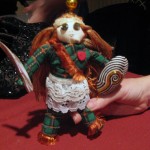
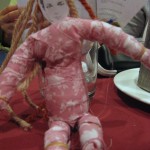
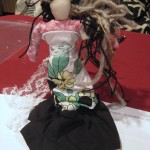
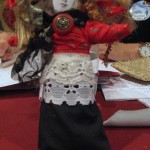
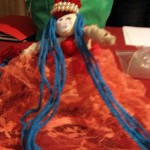
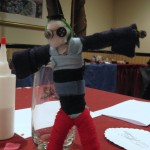
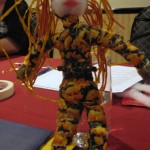
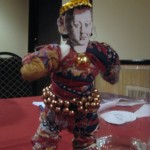

Le 5 oct 2011 à 02:23
Bonjour,
Je suis très intéressée à en connaître plus sur l’art thérapie et la fabrication de poupées, autant sur l’approche thérapeutique que sur la technique même de fabrication des poupées pour ce genre d’atelier. Je suis médecin de famille sur la Côte-Nord, et je me dirige tranquillement vers une formation en art thérapie. J’ai comme projet actuellement de monter un atelier de fabrication de poupées avec les futures mères autochtones innues de la réserve où je travaille et je cherche à m’outiller. Si vous avez des articles, ou encore des ateliers à me suggérer, je vous en serais bien reconnaissante.
Merci beaucoup,
Chantal Guillemette
Le 6 oct 2011 à 20:52
Bonjour Dre Guillemette,
Pour de la littérature sur le sujet, retournez au billet correspondant pour les références et liens. Il y a peu sur le sujet mais c’est un sujet qui génère un fort intérêt. Les applications multi-culturelles sont très pertinentes, et le choix des matériaux pour leur fabrication un élément culturel à considérer. Tout un savoir était légué dans leur fabrication traditionnelle. http://www.civilization.ca/cmc/exhibitions/tresors/art_inuit/inart12e.shtml
A ce sujet je donnerai un atelier d’introduction de 4 heures (Montréal) au mois de novembre et une suite en janvier 2012. L’atelier sera en français.
Au sujet de l’art thérapie, vous trouverez des liens vers des sites reconnus sur mon blogue, autant dans les billets que dans la section à droite des billets. Le site de l’AATQ notre association professionnelle ici au Québec, vous donnera encore plus d’information: aatq.org
Bonne découverte
Le 15 nov 2011 à 20:35
Je suis éducatrice à l’Hôpital Pierre-Janet à Gatineau (santé mentale). Ma collègue et moi animons des ateliers où l’on utilise le médium des arts comme moyen de communication. Nous avons complété le micro-programme en art-thérapie de l’UQAT et souhaitons élargir nos connaissances et habiletés dans des domaines pouvant aider notre clientèle à s’exprimer par d’autres façons. Manon anime présentement un atelier de création de marionnettes et de mise en scène. Nous sommes intéressées à votre atelier de création de poupées thérapeutiques. Nous aimerions avoir plus d’informations sur vos ateliers (coût, matériel, durée, en français?)
Merci de porter attention à notre requête
Le 15 nov 2011 à 23:55
Bonjour Madame Cossette,
J’inscris vos deux noms sur ma liste de personnes intéressées et je vous tiendrai au courant. Entre temps je vous ai fait parvenir les détails via courriel.
Au plaisir
Francine Lévesque
Le 5 jan 2012 à 11:04
Bonjour, Francine,
This is a great story and really nice work. I am interested in drama therapy as I am also a musician. Do you know how I can get in touch with Ms. Biancolin? an email or website would be very helpful.
Merci!
Le 10 fév 2012 à 04:31
information transmitted to Ms.Biancolin.
Le 11 nov 2014 à 01:17
Bonjour, Francine
I am a final year MA Art Psychotherapy student in the UK, currently writing my dissertation on the use of Doll Making in Art Therapy, whilst also being involved in making dolls as part of my own private therapy with a Drama Therapist. I am also including in my dissertation a small section on the uses of Doll Making in Drama Therapy and the Expressive Arts Therapies as I am very interested in the similarities and differences between the modalities.
During my research I discovered the MA dissertation written by Renee Biancolin. I was extremely interested by the ideas she put forward in her proposed treatment program and was intrigued to know if she had implemented her plan in a group setting since writing her dissertation.
In my online search for a way of contacting her, I came across this blog post and wondered three things.
1. Did you use any of her ideas in your workshops?
2. Have you written any case studies from the work you have done with doll making that I could reference in my dissertation?
2. Would it be possible for you to pass a copy of this enquiry to Ms Biancolin if you still have her contact details.
Thank you for taking the time to read my message and for any assistance you feel able to give me.
Kind Regards
Eunice Whitaker
Pingback: Art Therapy and Doll-Making – Jessica Le Art Therapy MA